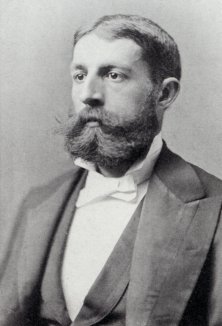In the late 1870's, Vassily Vereshchagin, Russian soldier, adventurer and painter extraordinaire, visited India. He spent 4 years wandering through India, visiting Delhi, Agra and Jaipur, the Himalayas and Tibet.
When he returned to Paris, where he was based, he produced this wonderful painting of the mosque at Fatehpur Sikri (City of Victory). This has to be the most gorgeous mosque wall I have ever seen!
The painting is called "etyud iz puteshestviya v Indiyu" (Sketch from a trip to India)
Vassily Vereschagin - Dated 1880 on the reverse - Oil on canvas
Image size: 14.5 inches by 17.75 inches
I know everyone says Shah Jahan (who later built the Taj Mahal) was the greatest among the Mughal builders, but this mosque at Fatehpur Sikri, built by Shah Jahan's grandfather Akbar the Great, is really something! Frankly, given the scale of building at Fatehpur Sikri - and the amazingly short duration in which it was achieved - I am tempted to call Akbar the greatest of the Mughal builders.
For those who don't know the history, here it is in three lines: In 1571, a grateful Emperor Akbar decided to build a city at the site where the Sufi saint Salim Chishthi lived. The saint had successfully predicted the birth of Jahangir, Akbar’s much-longed for son and heir. The Great Mughal took personal interest in the design and construction of his new city, bringing into it, dramatic combinations of Persian, Hindu and Jain architecture.
The city was built in just 15 years - an amazing feat. In 1585, the English traveller Ralph Fitch described Fatehpur Sikri as "considerably larger than London and more populous". The City comprised a series of palaces, public buildings and mosques. There were living areas not only for the members of the Mughal court, but also for the army, tradesmen, merchants and ordinary folk.
At the heart of the city was the Jama Masjid mosque (the painting above by Vereshchagin is of the innermost part of the mosque, the mihrab where prayers are offered). The compound of the mosque had a marble shrine dedicated to Salim Chishthi. Here is another painting, this time by an American who visited Sikri. Edwin Lord Weeks was born in Boston, and also travelled extensively, including 2 long visits to India in the 1880s and 1890s.
Festival at Fatehpur Sikri, by Edwin Weeks
Image size: 29.13 inch wide x 24.02 inch high
The image shows the marble tomb of Salim Chishti
Even to someone who doesn't understand art, the similarities in the painting styles of the Russian and the American are visible, aren't they? Both paintings are influenced by Jean-Leon Gerome, the Parisian Orientalist. Vereshchagin studied under Gerome in Paris, although he later developed a divergent style of his own. Edwin Weeks applied, but did not initially get admitted to Gerome's atelier, and studied under Leon Bonnat, a friend of Gerome (who also travelled with Gerome to North Africa and painted scenes of bazaars etc).
For these Orientalists, who wanted realism, colour and vibrancy, Africa, the Middle East and India provided fertile grounds for their paintbrush. If you want a closer look, you can check this link to Edwin Week's works.
Happily, most of Fatehpur Sikri is well-preserved even today, thanks to being "abandoned" by Akbar after just 10 years. Akbar wanted to focus on his war against the Afghans, and he chose a new capital, Lahore, in present day Pakistan. So Fatehpur Sikri remained intact, and unused...lucky for us!
See the photos below - you can compare it with the paintings above, and see that much of it is still available to us, although of course, the painter's eye and craft bring a sense of aesthetics that the camera cannot!
The mihrab at Jama Masjid, Fatehpur Sikri
Photo by Saumil U Shah (check out also his great collection of Agra photos)
Quwwal musicians outside the tomb of Sufi mysic Salim Chishti
Photo from Wikipedia
And before we end this post, don't you want to see what these painters themselves looked like? Here's the Russian Vereshchagin - interesting looking man, no? Just what I imagined! Dramatic and larger than life!
And here is Edwin Lord Weeks:
Don't let the boring portrait fool you, though. Both men were adventurers, setting out to see distant lands and places in an era when travel was far more difficult than it is now! Edwin Weeks, for instance, travelled by ship, train, horses and camels all over the Middle East, and camped where he could. Thankfully, his paintings of Indian life brought him fame both in France and America. He was thus eventually able to afford a splendid residence with a huge atelier in Paris. I don't particularly like starving artist stories, so I am very pleased to know that he actually enjoyed commercial success! :)

.jpg)



